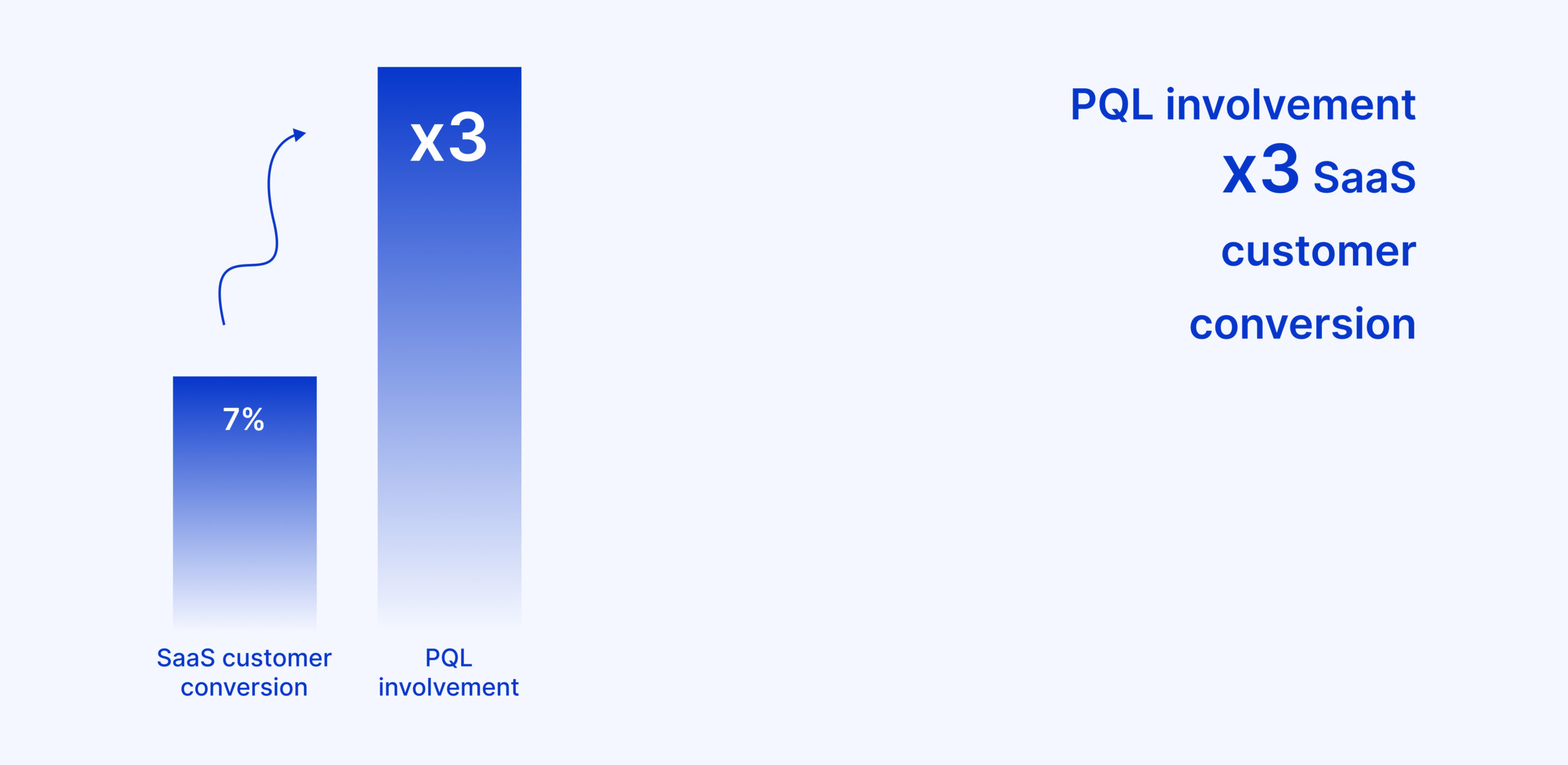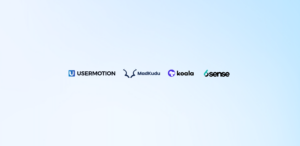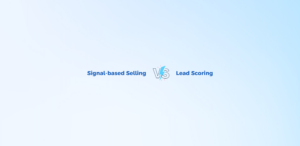Most B2B SaaS companies like yours adopt and invest in a PLG system to grow revenue faster at scale.
The data suggests so, too: 58% of companies already have a PLG motion in place, and 67% of companies in the $10M-20M ARR range plan to double their investment.
But, it is useless if it doesn’t lead to increased customer conversions. Your business doesn’t exist without it.
This article will discuss the role of PQLs in customer conversion, how to use them to increase conversion, essential tools, strategies, and more.
TL;DR
- According to Capterra, about 7% of website visitors typically convert into leads.
- Recent data indicates that free trials with PQL involvement convert at a rate almost 3x higher than freemium offers.
- PQLs have several roles in customer conversion, from involvement in the sales funnel to customer engagement and product marketing.
What is customer conversion in SaaS?
Customer conversion in SaaS refers to the transformation in the customer journey where trial users or visitors become leads. This transformation might include different stages until the user becomes a paying customer.
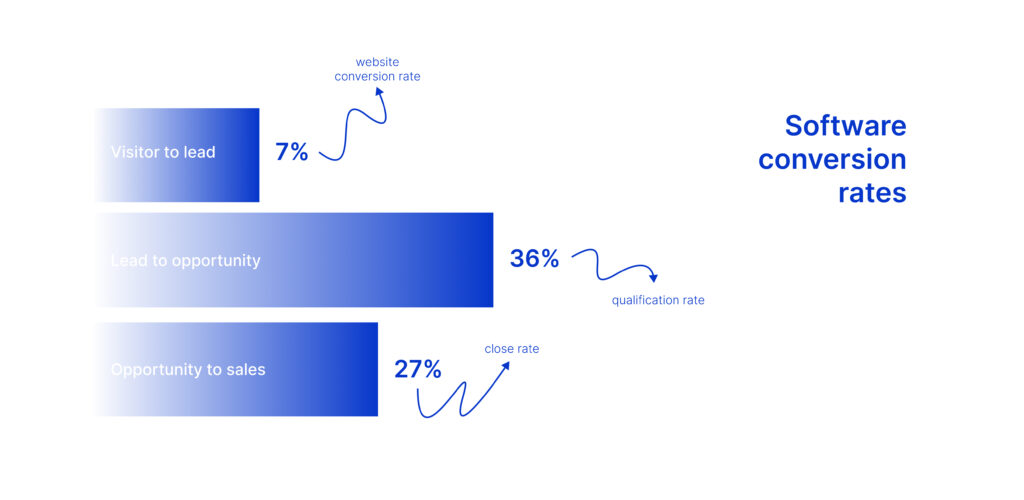
But why is this so crucial? Because this conversion process shows how well a product works and how valuable it is to potential customers.
Customer conversion is more than just a metric—it’s what keeps SaaS businesses alive.
It directly helps the company make more money and makes sure it will be around in the long run. If a SaaS business wants to do well, it needs to keep a close eye on this metric because it helps shape and improve marketing campaigns, product development, and the business’s overall strategy.
Let’s see how closely customer conversion is tied to PQLs to increase the rates.
What are product-qualified leads?
Product-qualified leads are like shoppers who’ve tried on clothes in a store, showing genuine interest and a higher likeliness to buy.
In the B2B context, they’re accounts that derive value from your account, fit your ideal customer demographic, and show buying intent.
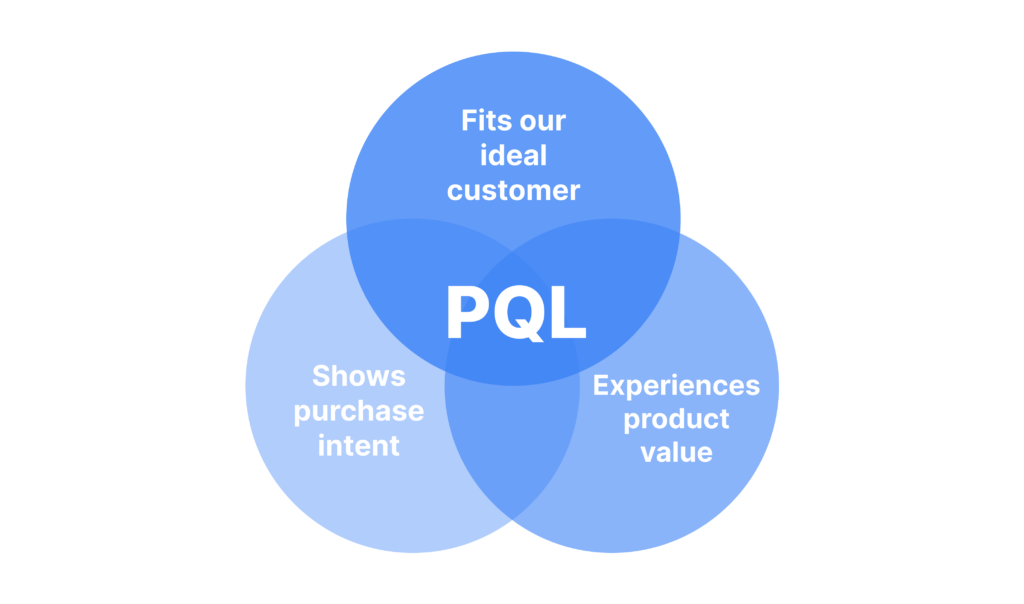
PQLs are used in an individual context, while PQAs (product-qualified accounts) are used by B2B companies.
They are also starkly different from MQLs and SQLs used traditionally.
In marketing terms, MQLs are leads who’ve interacted with your company’s marketing resources. In contrast, SQLs are leads who’ve expressed interest in your company’s products by talking to a salesperson, booking a demo, etc.
Continuing our clothing shop analogy, an MQL might be like a window shopper who shows interest in your store’s offerings by looking at them or signing up for some promotional material.
Similarly, an SQL might be a prospect who stops to talk to a store representative about their specific clothing preferences, or size.
Role of PQLs in customer conversion
Sales is all about reaching the right leads at the right time. A traditional company’s KPI is the number of MQLs and SQLs generated.
That sets the wrong priorities. Marketing only cares about hitting the MQL numbers and handing them to sales without proper vetting.
Sales is overwhelmed due to the massive number of leads sent to them. They reach out to anyone and everyone and end up converting no one.
On the other hand, in PLG companies, the primary metric for sales, marketing, and product is PQLs. They’re based on fit, value, and buying intent, which automatically leads to the prioritization of the best leads.
The result is more customer conversions and fewer sales resources being used. The data backs it up too.
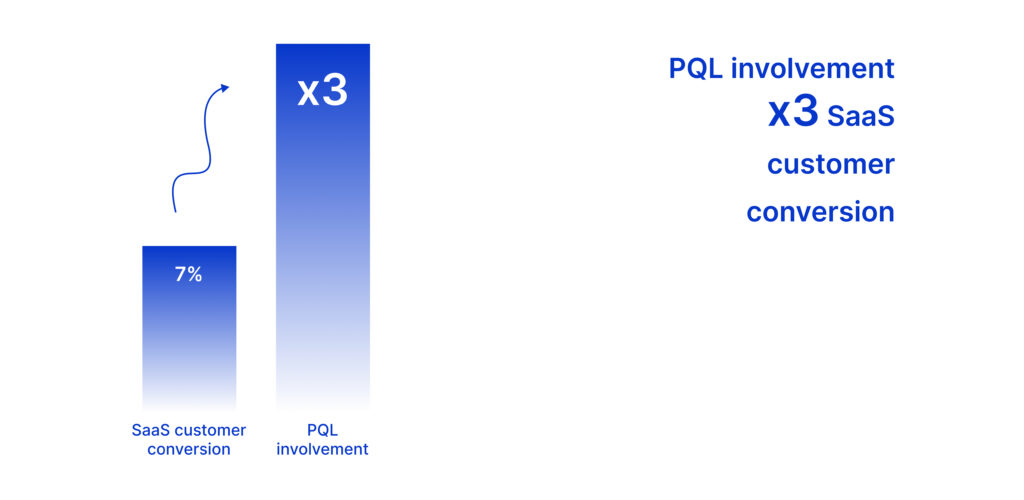
PQLs have a 20-30% customer conversion rate compared to just 7% for the average lead.
It’s because PQLs are based on tangible product data. They can easily be segmented and assigned scores based on their buying readiness to help you prioritize.
Tracking them also requires a lot of product data to assist you with personalized messaging and product development, which is crucial for customer conversion.
Impact on sales funnels
PQLs completely change the composition of the sales funnel.
In a traditional company, you have the following stages:
- Visitors
- MQLs
- SQLs
- Opportunities
- Customers
The high-friction process requires constant back-and-forth with the sales team to go from software demos to organization-wide adoption.
Contrastingly, PQLs follow a much shorter and more efficient sales funnel:
- Visitors -> Free trial/freemium signups -> Customers
OR
- Signups
- PQLs
- SQLs (Optional)
- Customers
Here the prospect is left to explore the software themselves, along with supporting resources and docs to help them solve issues.
You often don’t need a sales team unless you sell to enterprises.
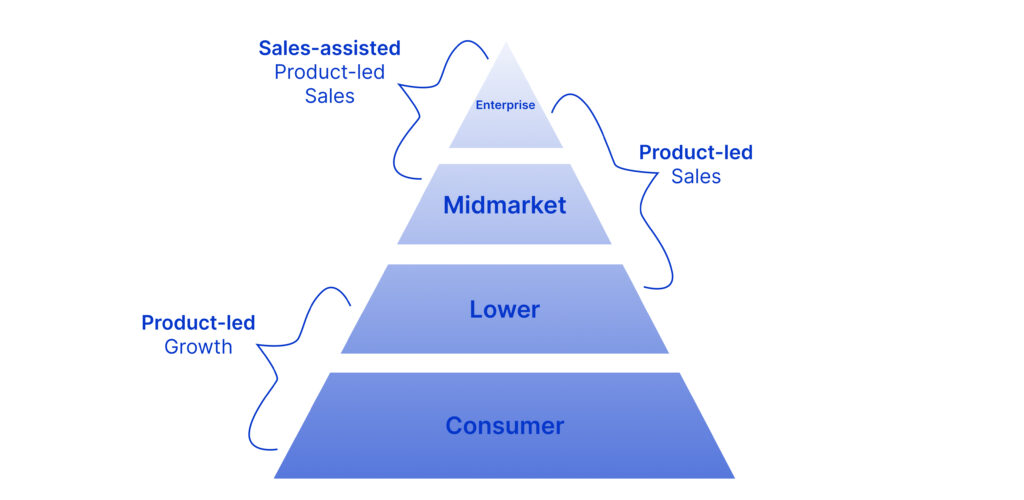
The major benefit of PQLs in the sales funnel is that it helps AEs focus on the right leads.
The BANT framework (Budget, Authority, Need, and Timing) for identifying high-priority leads is much easier to implement with PQLs.
You can learn about:
- Their budget during the onboarding questionnaire
- Decision-makers product engagement using analytics
- The need is already there as they are actively using the product
- Timing can be identified through their in-product actions and other signals
PQLs and customer engagement
You need a mindset shift to implement a PLG motion.
Your end goal should be ‘How do I help the customer achieve XYZ’ instead of ‘How do I increase my revenue.’
For example, at Figma, their goal was not to ‘make the design tool better.’ Rather, it was to ‘help people design better.’
It might seem small, but it makes a huge difference.
The meaning of customer success also differs in the two models. In a traditional context, customer success comes into effect after the purchase. It focuses on providing value and upselling the customer.
However, in a PLG model, customer success comes into play right from acquisition. The person doesn’t pay until they’ve realized the product’s value.
Customer success is everyone’s job in a PLG system. Talking more to customers than coding might seem unproductive, but it actually leads to faster product development in the right direction.
Also, the heaps of product data associated with PQLs can help you design better onboarding, a more intuitive product, reduce time-to-value, etc., ultimately leading to better user engagement.
PQLs and personalized marketing
A key qualification criterion for PQLs was ‘target ICP fit.’
You need a deep understanding of your target audience’s pains/problems/fears/JTBD, etc., to market to them.
By tracking PQLs correctly, you can identify patterns that can help with personalized marketing at scale.
Segmentation is much easier, which can help you tailor your messaging and content accordingly.
For example, you could send a targeted email to someone struggling with a specific feature and something else to someone who achieved PQL qualification criteria.
For a product-led sales motion, the product usage data can lead to a greater understanding of their needs and problems, which can help you during the sales call. The same can be said for renewals and expansions too.
💡Customer Conversion aka PQL Conversion in PLG
For companies adopting PLG, discussing customer conversion often implies discussing PQL conversion. So, if you’re using the PLG framework, it’s not just a matter of semantics to call your customer conversion rate your PQL conversion rate.
Either way, this rate is a key indicator of how well your product can attract, engage, and bring casual users to a point where they see real value in what you have to offer. In the PLG model, where the product is the main thing that drives growth, it is important to understand and improve this conversion rate. It’s not enough to just count how many people sign up; you also need to find out how many of them find the value proposition compelling enough to move from being interested to being committed.
Also, the higher your PQL conversion rate, the more clear it is that your product experience meets the needs and expectations of your users. So, in a PLG environment, keeping an eye on and improving this rate is a direct way to improve user satisfaction, build loyalty, and, ultimately, drive sustainable business growth.
Implementing a PLG system
PLG companies require a more complex infrastructure setup than touch models because data is key here.
First, you need a product analytics tool like Amplitude or Mixpanel. They will help you learn how users interact with your product, visualize how they convert, run feature experiments, etc.
Then, you need your regular marketing, sales, and support tools like Salesforce, Zendesk, etc.
Next, you need a data warehouse like Snowflake or BigQuery to store data from your product analytics, sales, and marketing in a centralized place.
In between, you’ll need an ELT tool like Fivetran or Cloud Functions to extract, clean, and upload raw data to the warehouse.
Finally, you’ll need a reverse ETL tool to send only relevant data from the warehouse to your marketing and sales tools.
For example, Mixpanel sells using a self-serve model with a sales-assist.

Here’s the infrastructure they use for their PQL system:
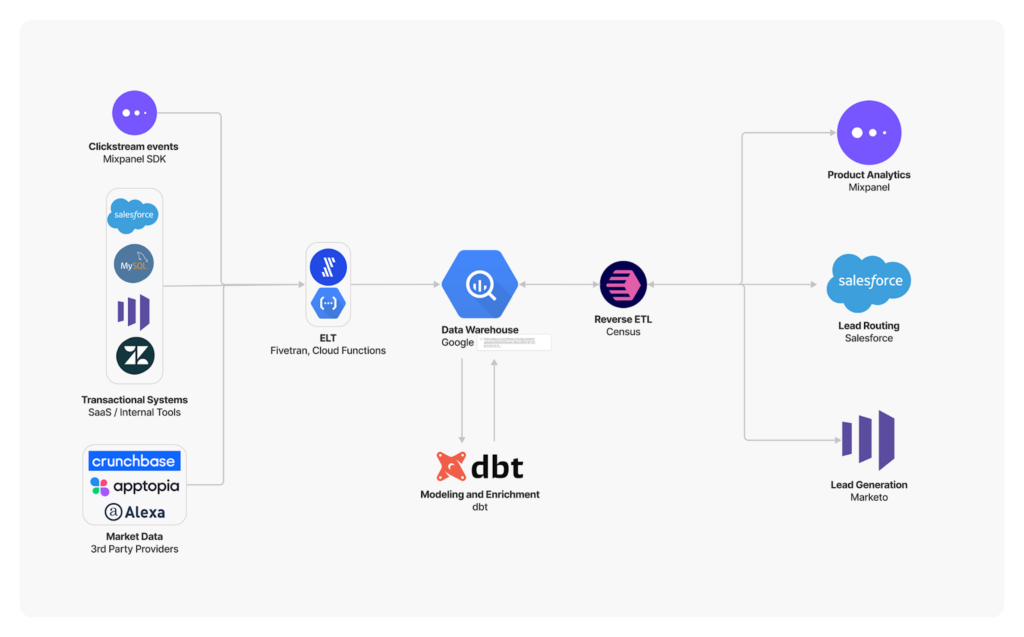
Here’s what they do:
- Identify users across data sources using their unique user ID.
- Link the users with their product usage data and upload them to BigQuery (their data warehouse).
- Then, they create Salesforce accounts for new signups and link users to their interaction with marketing assets. All of this data is sent to the warehouse.
- To help their sales team prioritize, they gather company data from Crunchbase and Alexa and only send those leads back to Salesforce that fit their ICP and has reached activation.
Implementing a PLG system isn’t as easy as providing a free trial option. A lot more goes behind the scenes to make sure that it works.
| Frontend Tools: enable PLG | |||
| Product Analytics | Product Experimentation | Lifecycle Marketing | Product-led Sales/Predictive Lead Scoring |
| Amplitude, Mixpanel, Pendo | Optimizely, VWO, Eppo | Braze, Customer.io | MadKudu, UserMotion, Outfunnel, Endgame |
| Backend Tools: enable customer 360 | |||
| Data Warehouse | CDP | ETL | Reverse ETL |
| BigQuery, Snowflake, Redshift | Segment, Amplitude | Airbyte, Fivetran | Census |
Strategies for leveraging PQLs to improve customer conversion
Here are some tried and tested strategies that you can use to improve PQL to customer conversion and revenue growth (these vary for self-service and sales-assist models):
Make your product easier to navigate
Self-serve customers care a lot about user experience. Customers who opt for a self-serve model want to get work done faster. If your tool isn’t a roadblock, it’ll make them fall in love with it.
For this reason, focus on crafting an intuitive, user-friendly product interface. An uninterrupted, smooth experience usually results in heightened customer retention and loyalty.
Next, strive for clear, accessible pricing. Simplify the process for users to comprehend your pricing model and its upgrade paths. For instance, at GitLab, a significant percentage of free users were unaware of where to purchase a paid plan.
Nurturing campaigns
Remember, a PQL is not just a lead; they’re on a journey toward becoming a paying customer. A PQL undergoes a journey, and they need nurturing before paying.
You can create a PQL lead scoring system, based on which you nurture leads with emails, blogs, support resources, etc., depending on how far along they are in the buying cycle.
The best part is that the entire process can be automated at scale. As your user base grows, having automated systems in place ensures that no potential lead is overlooked.
Leverage product-led marketing
Existing customers realize the value of your product. Why not use them to attract more such customers affordably?
You can build virality inside your product to attract more external customers, and even more internal users, leading to account expansion. For example, by incorporating features that make it easy and appealing for them to share or recommend your product, you turn your existing user base into powerful marketers.
Think of it as word-of-mouth in the digital age. Not only will this bring in new customers from the outside, but it can also motivate teams within existing customer accounts to adopt your product more broadly. This strategy not only grows the number of individual users but can also lead to bigger contracts and expanded accounts.
Conclusion
This article shares what PQLs are, their role in customer conversion, and how they impact sales funnels, customer success, personalized marketing, etc.
You also learned about setting up a PQL system and some strategies for leveraging PQLs to increase conversions!
They require a much different approach than a traditional system but come with a ton of benefits.
We hope you learned something new, and are happy growing!
Frequently Asked Questions
What are the criteria for Pql?
There are three criteria for PQL, which are “fit in customer profile”, “signals of customer intent”, and “experiencing product value”. All of these qualify a customer from every perspective to higher the chance of customer conversion.
What is the PQL customer rate?
The PQL conversion rate shows the proportion of new sign-ups that convert into PQL status within a specified timeframe. Unlike the sheer volume of sign-ups, this metric provides a more nuanced understanding by focusing on quality over quantity.

